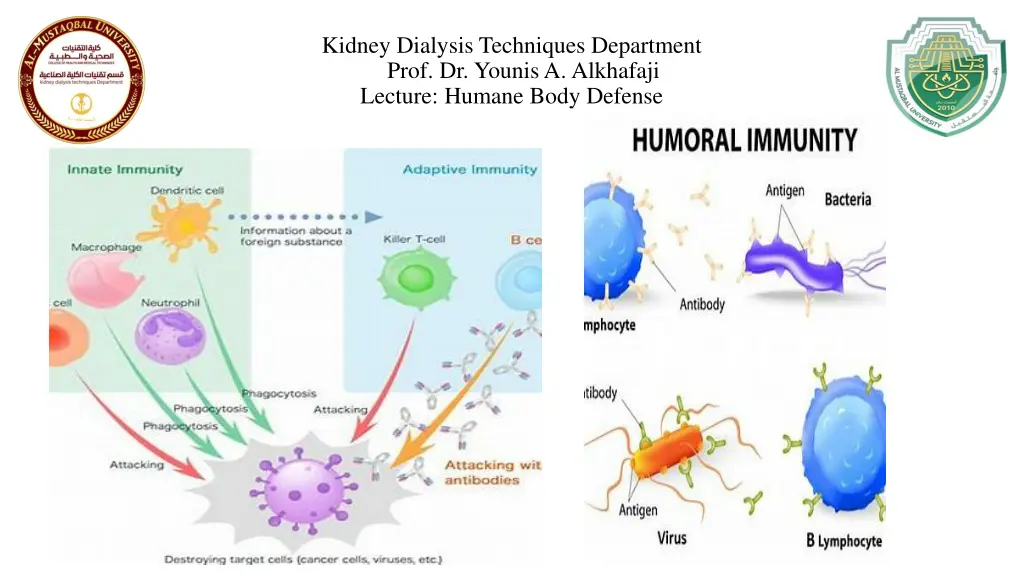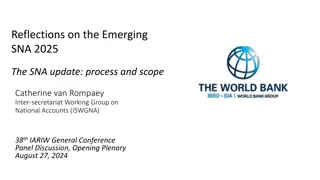
Understanding Kidney Dialysis Techniques and Body Defense Mechanisms
Explore the complexities of kidney dialysis techniques and the body's defense mechanisms against infections. Learn about the different lines of defense, including physical barriers, inflammation, and adaptive immunity functions. Discover the role of the complement system in intensifying the body's defense responses.
Download Presentation

Please find below an Image/Link to download the presentation.
The content on the website is provided AS IS for your information and personal use only. It may not be sold, licensed, or shared on other websites without obtaining consent from the author. If you encounter any issues during the download, it is possible that the publisher has removed the file from their server.
You are allowed to download the files provided on this website for personal or commercial use, subject to the condition that they are used lawfully. All files are the property of their respective owners.
The content on the website is provided AS IS for your information and personal use only. It may not be sold, licensed, or shared on other websites without obtaining consent from the author.
E N D
Presentation Transcript
Kidney Dialysis Techniques Department Prof. Dr. Younis A. Alkhafaji Lecture: Humane Body Defense
Lines of Defense 1st line Physical, biochemical, & microbiome Microbiome functions: Produce enzymes for digestion Synthesizes metabolites Releases antibacterial substances Competes w/pathogens for nutrients Fosters adaptive immunity Aids in communication between brain and GI tract 2nd line Inflammation Localized response & cleans up injury Characteristics: Occurs in vascular tissues Hemostasis Vasodilation Increased vascular permeability and leakage WBC adherence and migration Activation is rapid Response includes cellular and chemical components Nonspecific- response is always the same
3rd line Adaptive immunity Functions of Antibodies: Protect against infection Direct activation of the antibody alone Affect infectious agents or toxins through: Neutralization-inactivate or blocking the binding to cells Agglutination-clumping insoluble particles that are in suspension Precipitation-making a soluble antigen into an insoluble precipitate Indirect-requires activation of other components of the innate immune response Inflammation Phagocytosis Complement
Physical Barriers Skin GI/GU linings Respiratory tract Body Secretions Cell-derived chemical barriers Lysosomes attack bacteria Fatty acids and lactic acids create acidic environments Antimicrobial peptides kill bacteria, fungi & viruses Examples Tears, saliva, earwax, sweat Cardinal Signs of Infection Rubor (redness, erythema) Calor (heat) Tumor (swelling) Dolor (pain) Functio laesa (loss of function) **Initiation of Inflammatory Response Cellular or tissue damage Inflammatory mediators released which work together to destroy invaders, limit tissue injury and promote healing
Role of Complement System Intensifies or complements the capacity of antibodies and phagocytes to clear pathogens and damaged cells Activates inflammation Composed of many proteins Most potent defense to bacterial infection Three major path ways: Classic: activated by antibodies Alternative: activated directly by substances found on the surface of microorganism Lectin: activated by plasma proteins Role of Clotting System Forms a fibrinous meshwork of fibrin strands and platelets at an injured or inflamed site Prevents the spread of infection Localizes microorganisms and foreign bodies Forms a clot that stops bleeding Provides a framework for repair and healing Pathways Tissue factor (extrinsic)-activated by tissue factor which is released by damaged endothelial cells- outside Contact activation (intrinsic)-activated by damage to the vessel wall- inside
Role of Kinin System Interacts with clotting system Primary kinin is bradykinin- activates pain receptors Causes: dilation of blood vessels, pain, and smooth muscle contraction; increases vascular permeability Role of Opsonins, Chemotactic Factor, Histamine, Membrane Attack Complex, Leukotrienes, Prostaglandins, Platelet Activating Factor. Opsonins - C3b Coat the surface of bacteria increasing their susceptibility to phagocytosis by inflammatory cells Chemotactic factor- C5a Diffuse from a site of inflammation and attract leukocytes to that site Histamine- C3a + C5a = anaphylatoxins Substance which induces vasodilation and increased capillary permeability Membrane Attack complex- C6-C9 Leads to bacterial destruction and tissue injury by creating pores in the outer membranes of cells or bacteria. These pores facilitate the infusion of water into the cells culminating in cellular death.
Leukotrienes- slow reacting substances of anaphylaxis Lipids that induce smooth muscle contraction (especially bronchoconstriction) and increased vascular permeability. Prostaglandins Cause increased vascular permeability, neutrophil chemotaxis, and pain. Pain results from direct effects on nerves. Platelet activating factor Causes endothelial cell retraction, which results in increased vascular permeability, leukocyte adhesion to endothelial cells, and platelet activation and can activate mast cells. Acute and Chronic Inflammation Acute Self-limiting Lasts 8-10 days Local manifestations -Heat, swelling, redness, pain, loss of function Systemic manifestations Fever, Leukocytosis, Increased plasma protein synthesis What can we do to treat inflammation? Meds, ice, heat, rest, compression, elevation, NO opioids!!!
Chronic **Unsuccessful acute inflammatory response - Characterized by pus formation and incomplete wound healing **Microorganisms resistant to acute inflammation **Toxins causing tissue damage **Lasts weeks to months **Clinical manifestations **Dense infiltration of lymphocytes and macrophages **Granuloma formation **Epithelioid cell formation **Giant cell formation
Stages of Wound Healing Phase 1: Hemostasis (Coagulation) Tissue damage causes bleeding into wound Clot formation Platelet degranulation Increase capillary permeability Promote growth factors Phase 2: Inflammation Begins within minutes of injury Macrophages and mast cells release vasoactive cytokines Neutrophils infiltrate Lymphocytes initiate immune response
Phase 3: Proliferation and New Tissue Formation Begins 3-4 days after injury and continues for about 2 weeks Wound sealed and clot replaced with normal or scar tissue Macrophages invade to clear debris, release growth factors, recruit fibroblasts Angiogenesis formation of new blood vessels Lesion prepared for either regeneration or repair Granulation-tissue grows into the wound from surrounding healthy connective tissue Epithelialization-epithelial cells grow into the wound from surrounding health tissue Phase 4: Remodeling and Maturation Begins several weeks after injury and can up to 2 years Continuation of cellular differentiation Scar tissue formation Scar remodeling
Wounds Healing by Primary and Secondary Intention Primary (surgery- closed wounds) Secondary (wide open wounds) Necessary for Proper Wound Healing Granulation tissues (pink/red) Nutrition Oxygen Adaptive Immunity Develops slowly & the initial defenses against infection and promotes process against re- infection Lymphocytes and antibodies develop in response to infection Specific to infecting organism Mediators are long-lived and systemic proving long-term protection Has memory-provides long-term protection
Humoral Immunity When a B cell responds to an antigen it becomes a plasma cell capable of producing antibodies. 3 phases: B cell activation & differentiation Antibodies (IgG) production Primary and secondary immune responses Role of Antigens and Lymphocytes in Immune Response Antigens Molecules on surface of microbes, infected cells, or abnormal tissues Molecular targets of antibodies Common antigens: Infectious agents Allergens Chemical agents (including medications) Abnormal molecules on the surface of cells (cancers and infected cells)
Lymphocytes The body's immune response known as a white blood cell and the third line of defense in the body's immune system. They are divided into two categories, T lymphocytes and B lymphocytes. The T lymphocytes are more involved with the immune system and the B lymphocytes are responsible for making antibodies. Role of Major Histocompatibility Complex (MHC), Mast Cells, Macrophages, Erythrocytes, Neutrophils, Eosinophils, Basophils, Natural Killer Cells, T-helper Cells, T-cytotoxic Cells, T- regulatory Lymphocytes, Memory Cells, Plasma Cells Major Histocompatibility Complex (MHC) Necessary for cell mediated immunity Also referred to as human leukocyte antigens (HLA s) Glycoproteins on the surface of all human cells except RBCs. Divided into two classes based on structure MHC class I Present endogenous (intracellular) antigens Any change in a cell that causes abnormality may result in a foreign antigen being presented by MHC cells MHC class II Present exogenous antigens Only found on macrophages, dendritic cells and B lymphocytes
Mast Cells Scattered throughout the body in connective tissues Highly concentrated in the lungs, skin and GI/GU tract Responsible for secreting histamine when the inflammatory response is activated when the body needs to rid itself of allergens Macrophages Type of phagocyte responsible for eating pathogens and cancer cells by breaking down foreign materials Macrophages live in the blood vessels and will migrate over to the tissue once an injury has occurred Erythrocytes Red blood cells Responsible for the transport of oxygen throughout the body Neutrophils Type of phagocyte that respond early on in the inflammatory response Particularly attracted to bacteria and damaged tissue where they consume foreign materials Main ingredient in pus when an infection is present in the body Eosinophils Type of phagocyte that are attracted to parasites by helping the patient fight the infection and eliciting the inflammation response
Basophils Located in the blood waiting to be released into the tissues once the inflammation response has been activated Causes a release of histamine from its granules in the presence of allergens. Natural Killer Cells Type of lymphocyte that are activated by T cells lacking particular antigens Main responsibilities are to destroy cancer and viruses T-helper Cells Release cytokines which help B cells distinguish themselves from plasma cells and activate cytotoxic T cells along with macrophages T-cytotoxic Cell Main player in the body's adaptive immune system Known as world travelers through the body because they can cross the blood brain barrier, blood vessel walls and non-lymphatic tissues Activated by cytokines and attach themselves to cancer cells for destruction
T-regulatory Lymphocytes Suppress the immune system Memory Cells Divided into T and B memory cells B memory cells help the body to remember antigens and have a long life T memory cells are also long living but tend to stick around in case there are any additional pathogens T cells also produce cytotoxic T cells Plasma Cells Type of B cell responsible for producing antibodies Their life span is relatively short T Cells and B Cells T Cells Produced in the thymus T cell receptors (TCRs) recognize antigen Leave thymus, travel to and reside in secondary lymphoid tissue as mature immunocompetent cells B Cells Produced in bone marrow Each cell responds to only one specific antigen B-cell receptors (BCRs) recognize antigen Autoreactive B cells eliminated in bone marrow (those that respond to self-antigens)-referred to as central tolerance
Active and Acquired Immunity Active Induced thru a slower more specific process & targets particular invaders & diseased tissue Also involves memory which results in a more rapid response during future exposure to the same invader Acquired Induced thru a slower more specific process & targets particular invaders & diseased tissue Also involves memory which results in a more rapid response during future exposure to the same invader Functions of Antibodies (Immunoglobulins) IgG Most abundant (80%-85%) of the antibodies in the blood Most protective against infections IgM Largest antibody First produced during initial or primary response to antigens IgA Found in blood & secretions






















